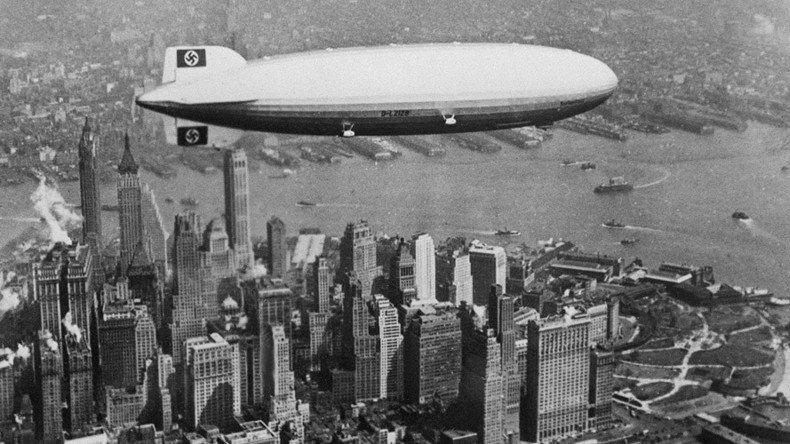80yrs on: Hindenburg disaster theories detailed in declassified FBI records (VIDEO, PHOTOS)

Some 80 years on from the Hindenburg disaster, doubt still grows over the cause of the devastating fire that brought down the airship.
Research into the iconic hydrogen airship’s demise has yielded many theories. The prevailing one, backed by the US Department of Commerce, is that a hydrogen gas leak was ignited by static electricity in the air – but decades later, the prospect that the luxury airship could have been sabotaged continues to garner intrigue.
The idea was raised once again at a memorial for the 36 victims of the tragedy Saturday.
See ground footage of the Hindenburg disaster, 80 years after the fatal flight. https://t.co/VQFKgPYlMKpic.twitter.com/xzCy7HEHus
— Getty Images (@GettyImages) May 6, 2017
Speaking at the US Air Force base in Lakehurst Maxfield, New Jersey, where the airship disintegrated in front of a shocked crowd, a relative of one of the engineers who worked on the Hindenburg shared his thoughts.
Wreath laying, Hindenburg memorial service. pic.twitter.com/de6Ht8Saa4
— Airships.net (@Airships) May 7, 2017
“We will never for sure [know] what exactly happened. Hopefully, it was not sabotage,” Dr Horst Schirmer said, as quoted by Asbury Park Press.
Due to volatility of hydrogen, history is littered with tragic airship accidents. But records show that the FBI did consider scores of sabotage theories in the aftermath of the disaster.
Clandestine communists
One suggestion was that the airship could have been destroyed by a secretive group of communists and anti-fascists. A declassified letter written by FBI special agent G N Lowdon highlighted remarks made in Communist Party of America newspaper, the Daily Worker.
Hindenburg, first landing at Lakehurst 1936. Again the size of this thing is amazing! Must of been a sight to see!! pic.twitter.com/sbTlXUFKny
— Real LordMC ☩ (@vincenzofabrini) May 2, 2017
Lowdon said a particular article in the newspaper caught his attention after reports in the US press about the “possibility that the ‘Hindenberg’ was sabotaged”.
He claimed the Daily Worker carried an article a week before the disaster claiming that German seamen were being recruited to do “perilous underground work aboard giant Reich liners plowing between New York and Germany.”
Although Lowdon said he found no evidence of this, it raised the possibility that there were clandestine groups preparing to sabotage transport systems associated with Nazi Germany.
Acrobat theory
Commander Charles E Rosendahl, who was in charge of Lakehurst Naval Air Station on May 6, 1937, told FBI investigators he saw sabotage as a “logical cause”. The FBI notes that “due to various happenings that have been called to his attention” Rosendahl is “of the opinion” that the fire in the gas shaft was started by an individual.
One incident said to have irked Rosendahl is an account by Dr Hugo Eckner, manager of Luftschiffbau Zeppelin, who interviewed Hindenburg staff after the incident.
Eckner allegedly told Rosendahl that the rule stating “a passenger was not to be allowed out of the passenger quarters unless in company with a member of the crew was not strictly enforced.”
Rosendahl then mentioned hearsay and suspicions about a passenger named Joseph Spah, who had been allowed to tend to his dogs in a freight room below the Hindenburg’s gas tanks. Spah was an acrobat, and according to Rosendahl could have conceivably used his abilities to reach the fuel area. The theory was not substantiated and came to nothing.
Media conspiracy
One of the more bizarre theories was that the members of the press had orchestrated the disaster for financial gain. US Air Force Colonel Harold E Hartney passed on a letter on the issue to the FBI dated May 11, 1937.
READ MORE: Super-zeppelin: Revolutionary airship may become cargo-carrying champion (VIDEO)
The sender’s name and address was redacted. The person wrote that “logical” thinking pointed towards the press as culprits, although the letter’s sender admitted to not having “direct evidence for my conclusions.”
Today in 1937: The Hindenburg crashes. Photographer Murray Becker captures it shot for shot: https://t.co/0P31RUwR1ypic.twitter.com/Xx3i1T9KHa
— amhistorymuseum (@amhistorymuseum) May 6, 2017
“The Hindenburg has been coming to this country for years. It was not extraordinary news… According to all the rules of human nature, most people wishing to take pictures of the ship would have left for home.
“With all this, this accident was photographed from every angle. As a matter of fact, I have never seen an event more profusely photographed,” the person wrote. “To me, it seems a possibility that a bunch of photographing racketeers would frame an accident of this kind, as they would any other big job for money.”
The bullet
Suggestions that the Hindenburg was brought down by gunfire was also widely mentioned.
#OnThisDay 1937 Marines at NAS, Lakehurst, NJ, help rescue survivors of the Hindenburg disaster. I still remember it. Big news then. #USMCpic.twitter.com/JyLYv7Aw4W
— Buck Miller, LtCol (@usmc1940) May 6, 2017
The bullet theory led Senator Royal Copeland of New York to contact the FBI on May 8, 1937. He also asked about speculation of mysterious footprints being found in a field near the crash site.
The FBI responded by saying that their agents investigating the area were “not impressed” with the prints. The declassified documents reveal the footprints were later identified as children’s and suggested they had been left a day after the Hindenburg explosion.












